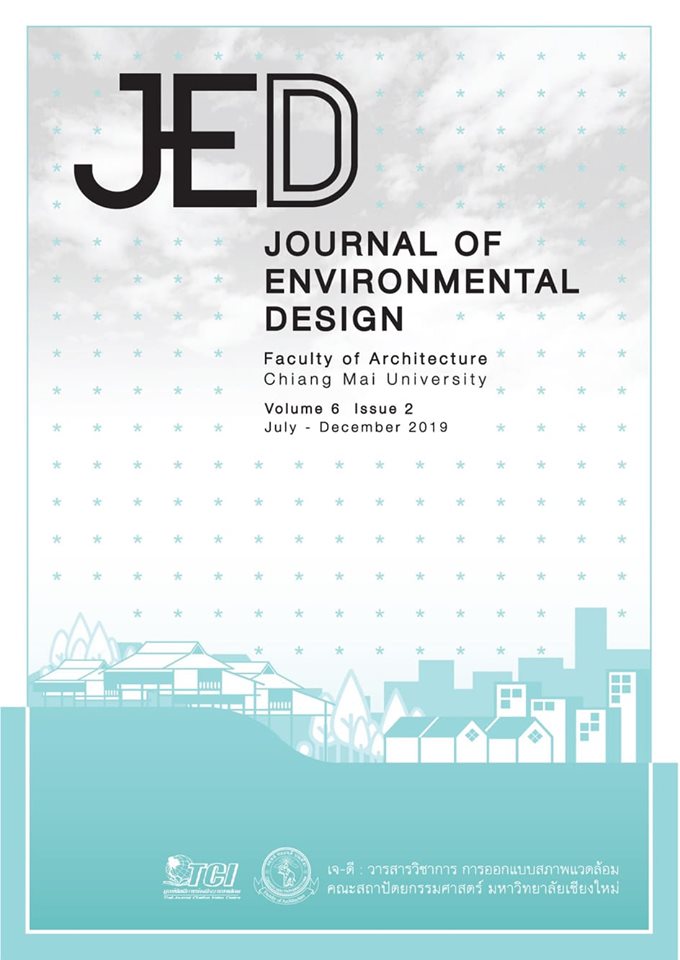การใช้โปรแกรมคอมพิวเตอร์ช่วยออกแบบและจำลองสถานการณ์เพื่อสนับสนุนงานบริหารจัดการด้านพลังงานในอาคารเรียน
Main Article Content
บทคัดย่อ
งานวิจัยฉบับนี้มีวัตถุประสงค์เพื่อศึกษาการใช้โปรแกรมคอมพิวเตอร์ช่วยออกแบบและจำลองสถานการณ์เพื่อสนับสนุนงานบริหารจัดการด้านพลังงานในอาคารเรียน เพื่อหาแนวทางการลดความร้อนเข้าสู่กรอบอาคารให้เป็นไปตามกฎหมาย และเพื่อเป็นข้อมูลสนับสนุนการตัดสินใจแก่เจ้าของอาคารในการบริหารจัดการพลังงาน ขอบเขตการวิจัยคือ พื้นที่ใช้สอยในอาคารเรียนของคณะเทคโนโลยีอุตสาหกรรม มหาวิทยาลัยราชภัฎสวนสุนันทา เครื่องมือที่ใช้ในการวิจัย คือ โปรแกรม ISA’s OTTV52 สำหรับคำนวณค่าความร้อนผ่านกรอบอาคาร และโปรแกรม Google Sketch up เพื่อจำลองการออกแบบสภาพแวดล้อมอาคาร วิธีดำเนินการวิจัยโดยสำรวจรางวัดกายภาพอาคารและอุปกรณ์ระบบไฟฟ้า บันทึกค่าอุณหภูมิและค่าความส่องสว่าง และใช้ช่วยจำลองการออกแบบและวิเคราะห์ผล ซึ่งผลวิจัยพบว่า อาคารเรียนมีค่าการใช้พลังงานไฟฟ้ารวม 349,542.12 กิโลวัตต์/ปี มีค่าความร้อนรวมผ่านกรอบอาคารสูงเกินค่ามาตรฐานมาก โดยเฉพาะในทิศตะวันตกเฉียงเหนือ ดังนั้นจึงเสนอให้ผนังอาคารเพิ่มช่องว่างอากาศ ติดฉนวนโฟมโพลีสไตรีนและกรุยิปซั่มบอร์ดแต่งผิวด้วยปูนยิปซั่ม เปลี่ยนฟิล์มกระจกหน้าต่าง ส่วนหลังคาเมทัลชีทเดิมเสนอให้ฉีดพ่นฉนวนโฟมสีขาวด้านบนเพื่อเป็นฉนวนและเพิ่มการสะท้อนความร้อน จึงส่งผลให้ค่าความร้อนรวมผ่านกรอบอาคารลดลงอย่างมาก ทั้งนี้ ได้จำลองรูปแบบการติดตั้งสวนไม้เลื้อยแนวตั้งในทิศที่ได้รับรังสีความร้อนจากดวงอาทิตย์โดยตรง ซึ่งแผงไม้เลื้อยมีพุ่มใบใหญ่หนา จะช่วยลดความร้อนเข้าสู่กรอบอาคาร ลดภาระการปรับอากาศและทำให้อุณหภูมิห้องอยู่ใกล้เขตสบายมากที่สุด เทคนิคธรรมชาตินี้เป็นการจัดการพลังงานในอาคารที่ยั่งยืน ต้นทุนต่ำ สร้างความร่มรื่นแก่อาคารสถานที่
Article Details
เอกสารอ้างอิง
Chaichana, S. (2016). Neawtang karn prubprung arkhan samnakngan satharanasuk changwat phuea prayat phalangngan. (In Thai) [Renovation strategies to improve energy saving for provincial health office]. Veridian E-Journal, 9 (1), 1703-1716.
CM coating team. (2018). Si sathon kwam ron ceramic coating technology. (In Thai) [Heat insulation ceramic coating technology]. Retrieved September 10, 2018, from https://www.cm-coatingteam.com/content/2624/insulation-ceramiccoating-coolhouse
Jekjantuek, T. & Kunkar, J. R. (2018). Karn chai prokraem chamlong lom ruam kub san neawtang phuea chatkarn phuenthee dai rub phonkrathob funla ong, phak utsahakam kosang. (In Thai) [Using a wind simulator program with a vertical garden to manage the affected area of the dust and construction industry]. Bangkok: Faculty of Industrial Technology, Suan Sunandha Rajabhat University.
Kespratoom, N. (2000). Phuettikam karn thaithe kwam ron khong phanang arkhan tee mee muansan mak. (In Thai) [Thermal behavior of high mass building wall]. (Master’s thesis). Bangkok: Chulalongkorn University.
Kunkar, J. R. & Krukaset, P. (2018). Karn oakbab prubprung krop arkhan ruam kub karn chai technique thammachat phuea phoem prasitthiphap karn prayat phalangngan nai arkhan rian. (In Thai) [Building envelope design with passive techniques to improve energy efficiency in the school building]. (Research report). Bangkok: Faculty of Industrial Technology, Suan Sunandha Rajabhat University.
Kunkar, J. R. & Wanwong, W. (2019). Karn oakbab prubprung prasitthiphap krop arkhan samnakngan lae karn prubprung saphabwaetlom arkhan. (In Thai) [Design of building performance improvement and improving building environment]. Proceedings of the 3rd Suan Sunandha Academic National Conference on “Education for learning development” 2019. (pp.1148-1157). Bangkok: Suan Sunandha Rajabhat University.
Minister of Energy. (2009). Kot krasuang kamnot praphet rue khanat khong arkhan lae mattrathan lakken lae withikarn nai karn oakbab arkhan phuea karn anurak phalangngan phoso 2552. (In Thai) [Ministerial regulations prescribing categories or the size of the building and the standards, criteria and methods in building design for energy conservation, BE. 2009], (2012, 30 November). Royal Thai Government Gazette. Rule Number 129 section number 122 ก. pp.9-15.
Nittaya, S. (1998). Karn oakbab arkhan samrab phumi akat khet ron chuen. (In Thai) [Tropical design environment]. (Master’s thesis). Bangkok: Chulalongkorn University.
Phichetsin, K. (2002). Neawtang nai karn prubprung phanang arkhan derm phuea lot karn thaithe kwam ron khao su arkhan. (In Thai) [A guideline for building wall system to improve thermal performance]. (Master’s thesis). Bangkok: Chulalongkorn University.
Prapasongsit, J. (2001). Karn oakbab prubprung rabob plueak arkhan phuea karn chai phalangngan yang mee prasitthiphap koranee sueksa: arkhan samnakngan thanakhan Thahan Thai (samnakngan yai). (In Thai) [Building envelope improvement for energy efficiency of existing building case study: Thai Military Bank (Head Office), Bangkok] (Master’s thesis). Bangkok: Chulalongkorn University.
Sunakorn, P. & Kasemsap, P. (2010). Samatthana karn dut sap khabon dai ok sai khong phanang mai lueai. (In Thai) [CO2 uptake performance of climbing plant wall]. Journal of Architectural/ Planning Research and Studies, 7 (2), 173-187.
Sunakorn, P. & Yimprayoon, C. (2011). Karn phoem samatthana nai karn thaithe kwam ron khong phaeng kandaet mai lueai duai karn rabai akat. (In Thai) [Increasing thermal performance of climbing plant shading by adding ventilation]. Journal of Energy Research, 8 (1), 38–53.
Thai Green Building Institute (TGBI). (2012). Ken karn pramoen kwam yangyuen tang phalangngan lae singwaetlom Thai samrab arkhan rawang chai ngan, sathaban arkhan khiao Thai. (In Thai) [Thai’s rating of energy and environmental sustainability for existing building: operation and maintenance, TREES-EB]. Bangkok: Author.


